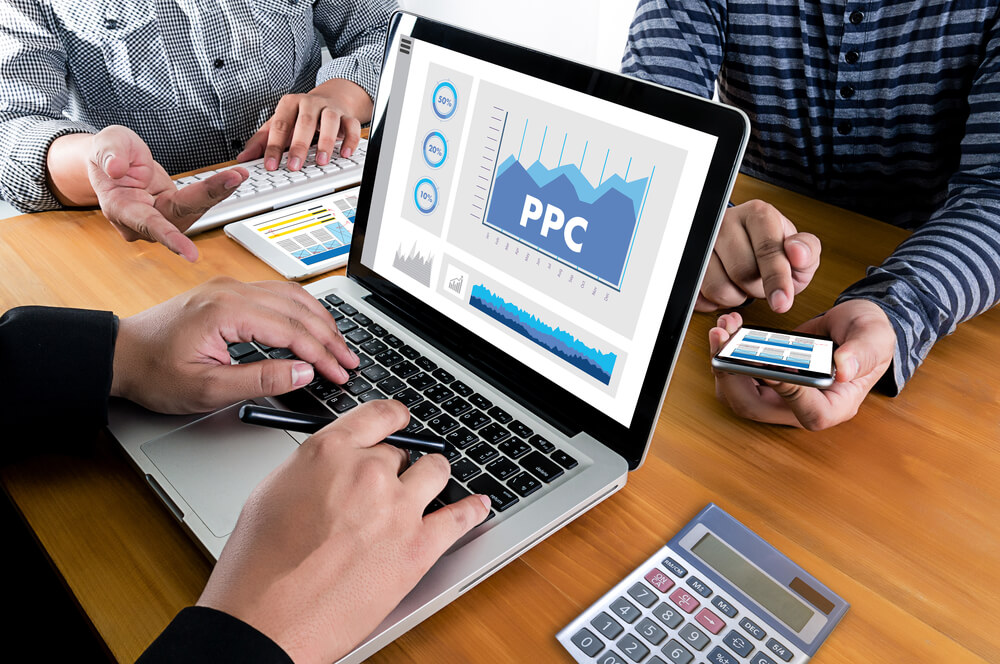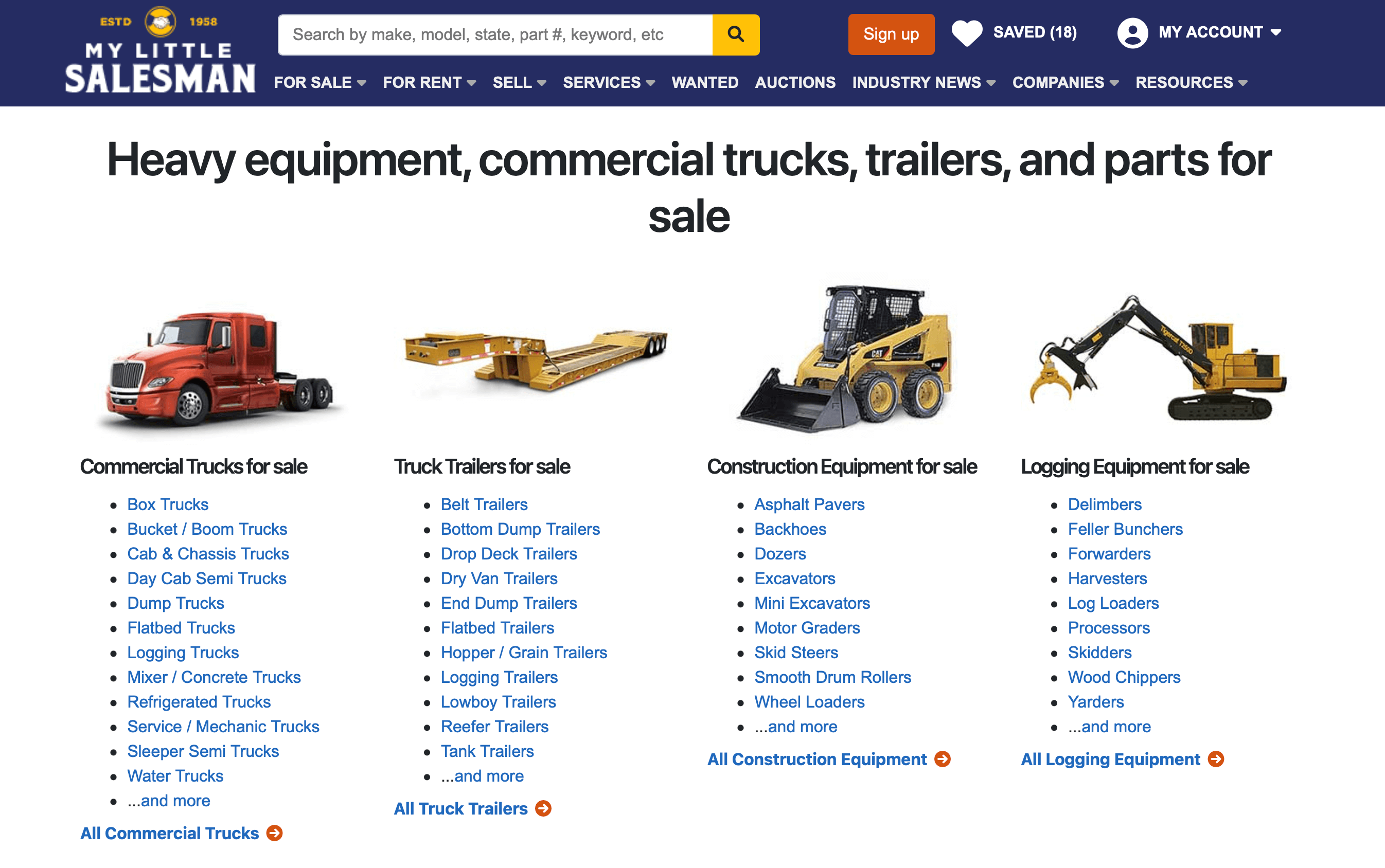
There’s no denying the convenience of shopping for virtually anything virtually. More and more buyers are turning to the internet before ever heading down the street to a physical store or even a dealership. This buyer behavior includes buying cars, excavators, backhoes, semi trucks, trailers, and beyond. For this reason, your dealership needs to remain relevant in both worlds.
In this guide, we’re going to look at seven proven strategies for developing a strong online presence for your dealership. Let’s dive in!

Your website is often the first impression your shoppers have with your brand, so it needs to make a great one! With that, responsiveness is key.
What does it mean to have a “responsive” website? Why is this important?
A website with a responsive design means that each page is designed to conform to any device viewing it. Responsive design entails that the size of the text and images automatically conform to the size of any smartphone, tablet, laptop, or desktop monitor browser.
Your visitors will be visiting your website on various devices—making responsive design imperative. Some may flip through inventory listings on their smartphone during a lunch break. Others may peruse equipment listings on their office computer. Having a responsive dealership website means you will be able to serve them both with the same design.
And this is more important for traffic retention than you may think. According to figures from Google, 61% of visitors are not likely to return to a mobile website they have trouble accessing due to a bad design. This means that if your website is at all difficult to use, most will simply click away to find another with a more user-friendly design.
When you’re looking to buy something, where is your first stop? If you’re like the 63% of people who begin any shopping experience online, there’s a 93% chance that you’re immediately heading over to Google to begin your search.

How does Google decide which websites to serve up to visitors?
There are a wide variety of website ranking factors search engines take into consideration, but most of the top-ranking websites abide by the standards of search engine optimization —or SEO.
What is search engine optimization (SEO)?
Search engine optimization is the process of making a website as appealing to search engines as possible. The better the “SEO” of a website, the better it tends to rank on the results page for users.
What makes one website more optimized for search engines than another?
Some such ranking factors include responsive designs, fast loading speeds, highly relevant content, and evidence of authority—such as other trustworthy websites vouching for the credibility of the website in the form of links.
Is SEO a worthwhile marketing investment?
Search engine optimization is not only a great way to increase the visibility of your website, but it also packs the most bang for your buck for any digital marketing expense. Though the process of gaining credibility with search engines may take time, the effects last longer and are much more affordable per visitor than paid advertisements. And organic traffic tends to be much less expensive than paid traffic.
What is “organic” traffic? How does it differ from paid traffic?
Any traffic that finds its way to your website via search engine results without the use of paid advertisements is called “organic” traffic—meaning it’s “organically” sought after. Search engines typically use the amount of organic traffic to a website as a sign of credibility and relevancy. Because most of your online traffic to your website will be routed via search engines, it pays to make sure your website is optimized to earn as much organic traffic as possible.
How can I optimize my dealership website for search engines?
There are several ways to make your website earn the attention of search engines.
- Use the right keywords: If you use the most relevant keywords for your website, search engines are more likely to connect your dealer site to relevant search queries. With this being said, don’t “keyword stuff”—or overuse these keywords. Use them where they make sense. Google will get the gist and keyword stuffing can diminish the user experience.
- Optimize your page titles and URLs: There should never be any mystery as to what a particular page is about. You can remedy any ambiguity by being sure to include relevant search terms in page titles and URLs.
- Make your website as user-friendly as possible: Visit your website in your target audience’s shoes. If there is something about it that annoys you, it will annoy them and cause them to click away. Fix it for the sake of visitors and search engines will appreciate it as well.
- Outdo the next site: The job of a search engine is to choose which websites best solve a user’s problem—and it has a lot of choices! However, if you can deliver high-quality content, a better user experience, and can get other websites to vouch for you, you can outrank them simply by working harder.
Keep Nurturing Your SEO Efforts
Like gardening, tending to your SEO efforts is by no means a one-and-done activity—it is ongoing. But the best way to optimize for search engines is to optimize for users instead. Keeping up with the latest search engine changes is difficult as they’re always chasing what users want. Keep up with what users want and you’ll remain a step ahead of the competition.

If you’d like to increase traffic to your dealership’s website, you need to give them a reason to visit—and also to return. How can you do this? By creating and publishing genuinely helpful content to earn traffic to your branded website—a process otherwise known as content marketing.
Start by Simply Answering Their Questions
In the process of shopping for heavy equipment, buyers have a range of questions. Why shouldn’t you be the one to answer them and in doing so, earn their trust? Well, you can—with your content.
And getting started in content marketing is fairly straightforward.
- Decide what audience makes the most sense to target.
- Meet with your sales staff to create a list of questions they receive regularly or questions this audience tends to have
- Answer them! Write in-depth buyer guides, articles, and other buyer resources you can provide on your website’s blog or a news section. And the less comfortable the question, the better!
Starting out, keep your content marketing simple by being as helpful as possible. It doesn’t have to be much more complicated than those three steps. You can always strategize and scale up later.
Repurpose Content
So, you’ve created pages and pages of wonderfully helpful content. Keep in mind that not all visitors will want to read a long guide or article. They may prefer to examine an infographic, watch a video, or listen to a podcast episode during their commute or on the job site. No worries! Fortunately for you, if you have a smartphone, you can get started making graphics, videos, or recording podcast episodes right now by “repurposing” the answers you’ve already conjured up for them. Let’s see a few examples of how this can be done quickly and easily.
Start Simple, But Start Now
Content marketing doesn’t have to be fancy—it just has to be helpful.
Here’s something you can do today:
- Pull out your smartphone
- Open the video camera
- Shoot a video of yourself or a member of your sales staff answering a buyer question and asking your audience to submit other questions for your team to answer
- Upload the video to YouTube or your dealership’s social media platforms
- Share the video on your blog
- Email it to your subscriber list
- Rinse and repeat
Getting started doesn’t have to be complicated.
Making a Podcast the Easy Way
More than ever, buyers have been seeking out educational podcasts to find answers to their questions, better understand a concept, or kill time during a commute.
Would you like to direct some of this traffic your way? Who wouldn’t?! Well, now you can do so using just the smartphone in your hand or pocket.
Here’s how to create a free dealership podcast:
- Download a free podcast creation app such as Spotify for Podcasters or Podbean
- Create your dealership’s podcast with the hosting platform (again, usually free!)
- Record a conversation with a member of your sales or service team about a frequently asked buyer question
- Feel free to be chummy and personable—as long as you provide valuable feedback
- Upload the recording as a show episode (some of these podcast hosting services allow you to record directly from their app)
- Submit the show’s RSS feed to Apple Podcasts for distribution
Scale Up Your Content’s Production Value Whenever You Want
For smaller marketing departments wanting to create content for their audiences, smartphone technology and media production applications have removed many obstacles. Sure, you may scale up your production quality or even consider hiring content marketing professionals at some point. For now, you can begin with the very smartphone you may be using to read this article.
Remember—all you need to get started in content marketing is a platform and a helpful spirit.

A quick way to boost visibility to your website or even specific inventory listings is with pay-per-click style advertising.
What are pay-per-click ads?
As the name suggests, pay-per-click (PPC) advertisements are ads you paid for per visitor click (or tap) to access. You’ve likely seen such ads at the top of a search engine results page or possibly on social media websites.
What are the perks of PPC advertising?
Quick Traffic
With PPC ads, traffic to your website is immediate. There’s no waiting for search engines to build trust in your website or for users to consume your content. As soon as your ad is live, you’ll likely begin to see traffic.
Real-Time Experimentation
Those who opt to use PPC advertising can test out various subject lines for effectiveness, carefully tweak advertisements, and choose to target specific demographics. You can even run several versions of the same advertisement simultaneously and set the platform to choose the more successful ad.
Budget Customization & ROI
Those opting for PPC ads can spend as little or as much as they want by setting budget limits. Despite this seeming to be a more expensive route in comparison to search engine optimization (SEO), many pay-per-click campaigns have a fairly high return on investment. According to Google, the average business engaging in PPC ads sees about $8 in revenue for every $1 spent.

Why does my dealership need to be on social media?
When engaging in marketing or advertising, it makes sense to go where your target audience spends time online. According to figures by social media distributor Hootsuite, there are over 3.8 billion social media users in the world with the average user spending over 2 hours a day using platforms such as Facebook, LinkedIn, Twitter, Instagram, Reddit, TikTok, and others. But how should you go about joining their conversation?
Go Where Your Audience is the Most Active
When crafting your approach, take some time to research which social media platforms your target audience uses the most. Is it Facebook? Instagram? Twitter? Reddit? Though covering several platforms is helpful, start out by targeting your audience’s favorite platform. You can always scale up later.
Craft Your Tone Based On Your Audience
Once you have a shortlist of social media platforms to engage, decide what tone you’ll use to engage with your audience. Will they respond to entertaining posts or are they all business? Playful or serious, this tone should preferably be in line with your dealership’s brand image.
Leveraging Paid Ads Via Social Media
Paid ads on social media platforms, such as Facebook ads, are especially effective due to your ability to carefully control which demographic groups are served your ads. Because of the amount of data social media platforms are able to collect on users based on their behavior, targeting specific audiences can get so granular that it's almost creepy—but in a good way!
Use Social Media to Expand Your Content Marketing
If you’ve created helpful resources, your social media pages are great places to share them. Link to your online articles and guides. Feel free to upload videos directly to platforms and video-sharing sites like YouTube. Ask your audience to share posts and promote conversation by asking questions for them to answer in the comments sections. Engagement with your posts will encourage social media algorithms to expand the reach of your content even further to new users.

Email marketing for your dealership is more than announcing when items are on sale or about the latest company picnic. Instead, consider what it would take to make people eagerly anticipate the emails they receive from you—even when they’re not ready to buy.
Let’s look at what is required to accomplish this.
Segment Your Sender List
If an email is for everyone, this means most will have to skim through it to find what appeals to them. Instead, do the skimming for them! You can do this by segmenting your email lists into several different groups of people based on a variety of factors.
What are some good contact categories for email segmentation?
When putting different contacts into “buckets” or segmented lists, it may be helpful to divide them by a few factors, such as:
- Industry: Is this person in the construction industry? Trucking? Agriculture? Manufacturing? Different industries can mean different messages.
- Job title or seniority: Is this person a decision-maker or someone who can influence a decision-maker? Operators and buyers may be different groups.
- Location: Do you sell to different regions? It may make sense to tailor your messaging to certain groups based on location.
- Interests and behavior: What have they responded to in the past? What are they interested in learning more about? How frequently would they want to hear from you?
- Purchase history: Have they purchased from your dealership before? If so, they’re likely already sold on you. Keep them in your rolodex with helpful information and friendly messaging.
- Sales funnel position: Where is this contact in the “sales funnel”—awareness, discovery, evaluation, intent, purchased, or advocate? It may make sense to create lists for these different groups and install triggers that move them from list to list.
When you divide the lists by interests, you increase open rates, engagement, and traffic to your listings.
A good rule of thumb:
Don’t send emails to people who don’t want to receive your emails.
Make sure to provide something in the email that is valuable to the subscriber beyond the ways they can buy from you. Consider looping in your content marketing efforts—including buyers' guides, helpful articles, industry news, and the like.

Want to expand the visibility of your dealership’s listings? You can do so by also featuring them on online third-party equipment listing marketplaces. And there are several reasons why this can be immensely effective.
First-Stops for Shopping
Because many buyers are familiar with the listing services associated with the products they need, these sites may be some of the first places they go to see what is available. Why? Well, such online marketplaces allow them to search for various items available from multiple sellers—saving them some of the hassle of searching individual sources. By listing your inventory with these services, you’re more likely to attract the attention of highly motivated buyers.
Search Engines Like Them
Most successful online equipment marketplaces have search engine optimization (SEO) working in their favor. They’ve done the hard work to earn traffic from search engines for users that are further along in their buyer’s journey. By listing your heavy equipment with them, you can save yourself some of that work and get more engaged eyeballs on your listings.
Streamlined Design & Buying Experience
Listing services are only as good as the buying experience they deliver. For this reason, it is in their best interest to provide the best buying experience for visitors. Listing websites typically include easy search filtering, fast loading rates, responsive design, and a methodical buying process.
Start Building Your Web Presence Today…For Free!
Unlike marketing efforts of pre-internet times, you can begin building your equipment dealership’s web presence immediately. Though you may want to scale up your efforts later, you can begin expanding your dealership’s online presence today at no cost.
So, what will you do first? Brainstorm questions you’d like to answer? Overhaul some social media pages? Begin strategizing an email marketing campaign? There are no limits to what you can accomplish!
Ready to Scale Your Dealership’s Online Presence? We Can Help!
Find a Professional Web Developer with Dealership Experience
Unlike many websites, equipment dealership websites will need to display inventory listings and work in tandem with your dealer management system. Fortunately, your friends from My Little Salesman can help you build a custom dealer website—one that is fast, responsive, SEO-friendly, and works hand-in-hand with your Dealer Technology Solutions dealer management system.
List Your Dealer Inventory Now
If you’re ready to begin listing your heavy equipment inventory online with a leading third-party marketplace, your friends at My Little Salesman have made the process a snap. Since 1958, My Little Salesman has been connecting buyers and sellers of heavy equipment, commercial trucks, parts, and much more. And this reputation has continued into the digital age with top-tier online listings.
You’re invited to learn all about listing your inventory on My Little Salesman’s intuitive marketplace today.